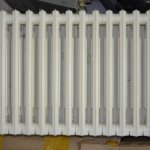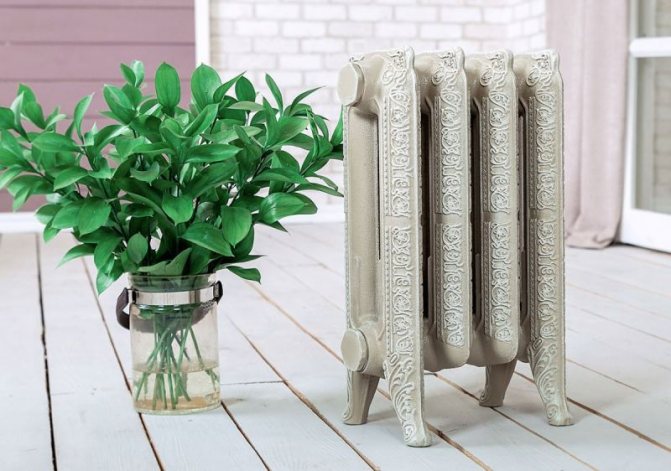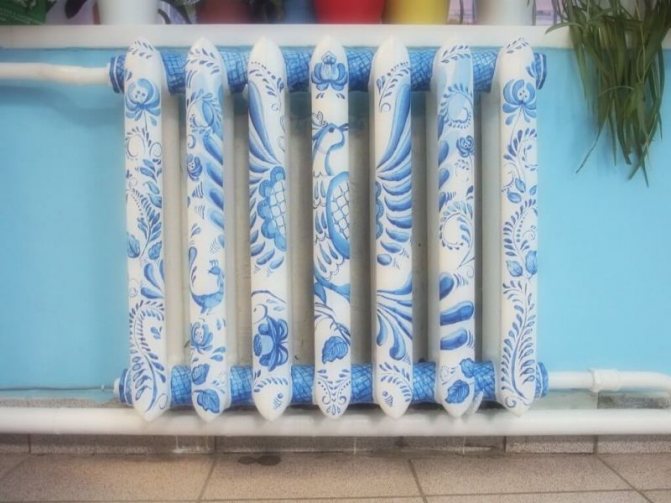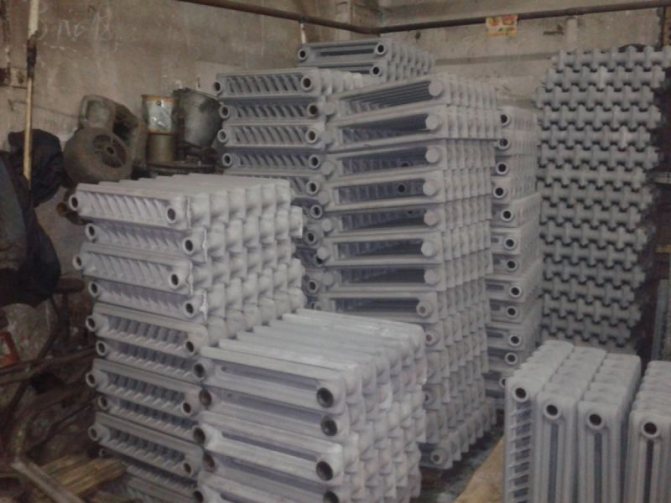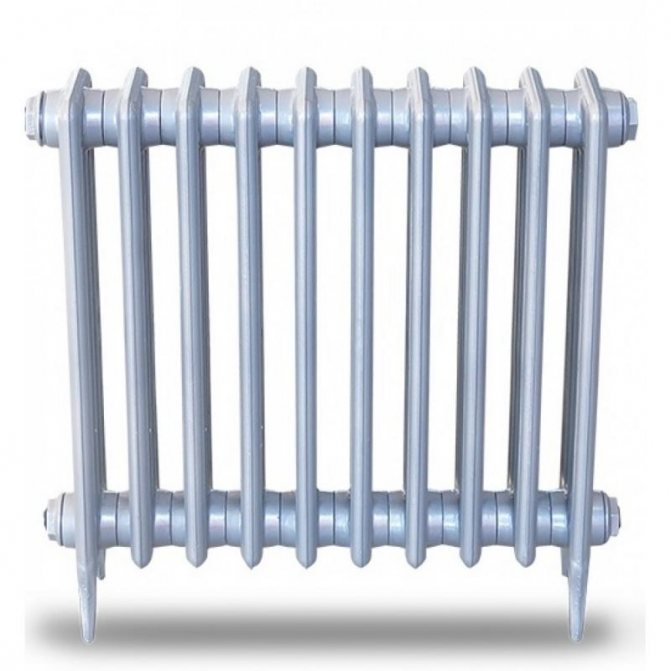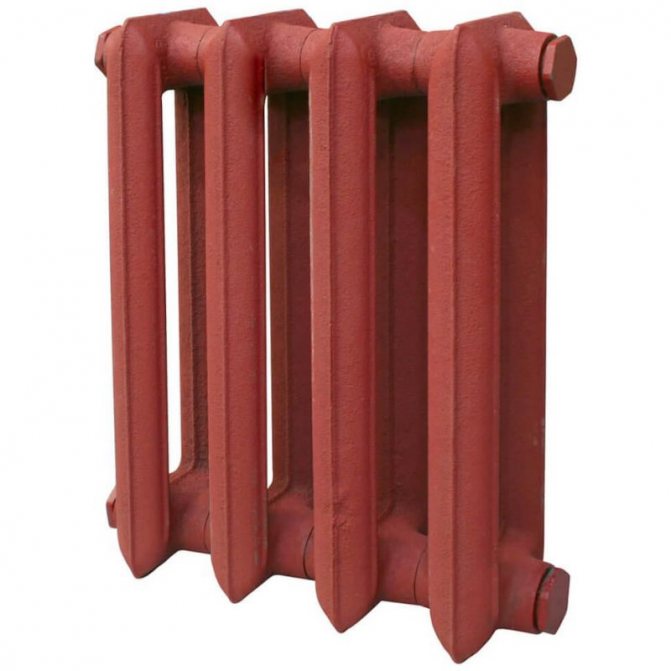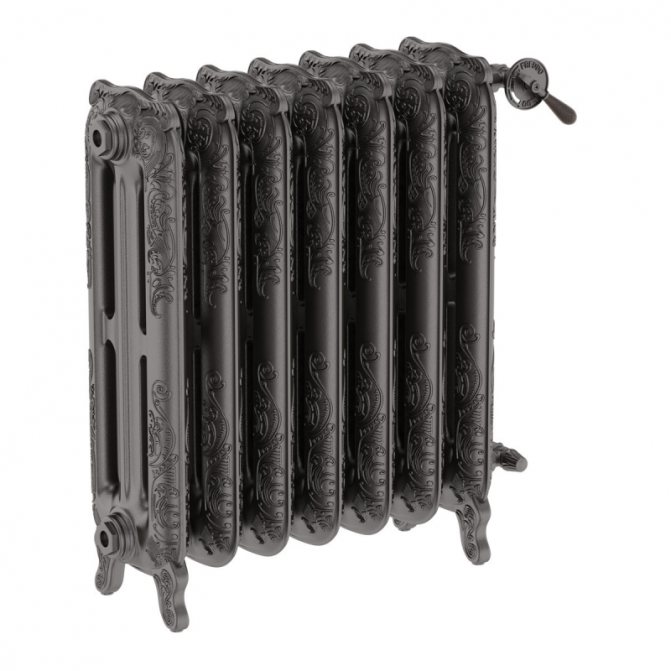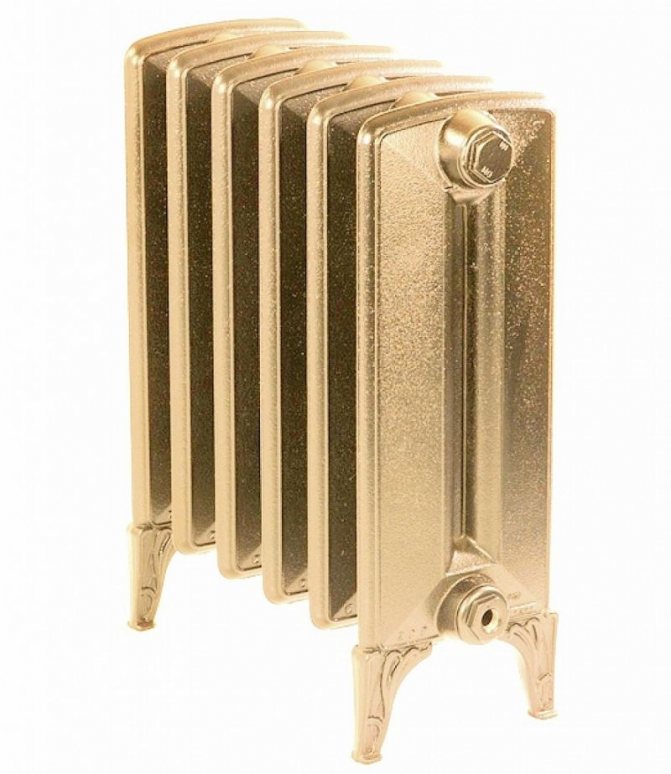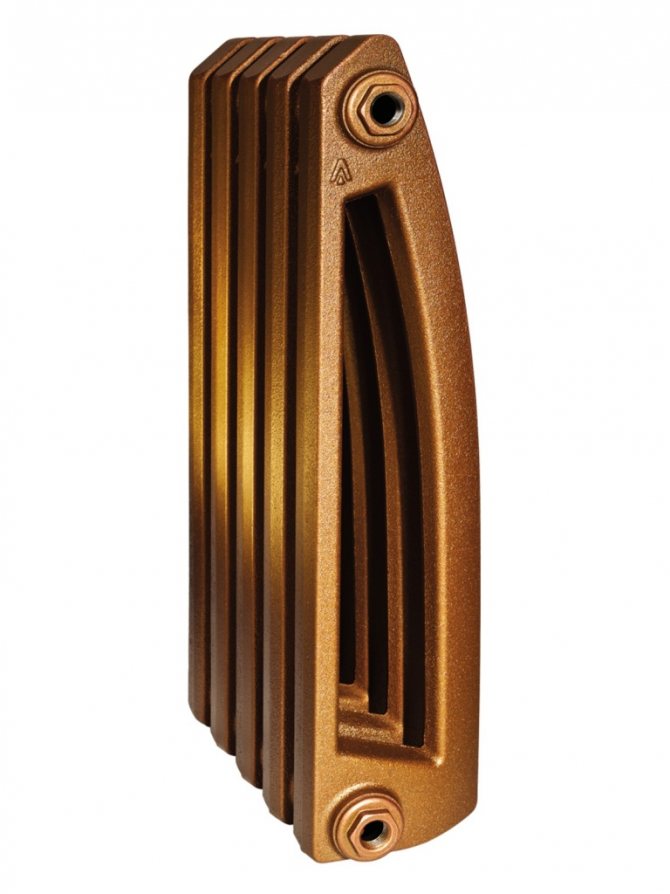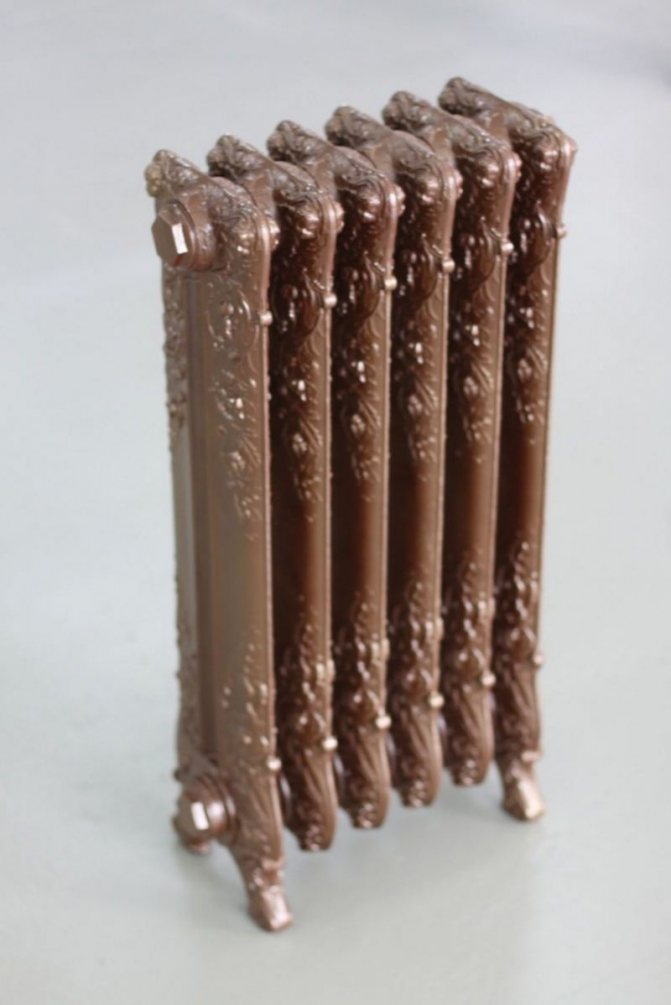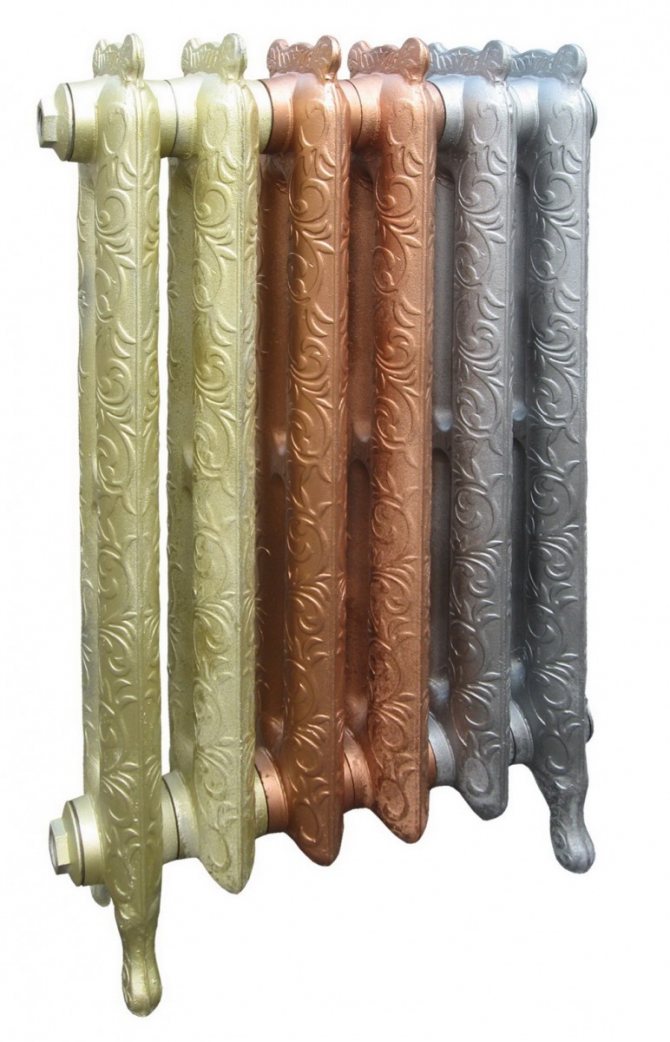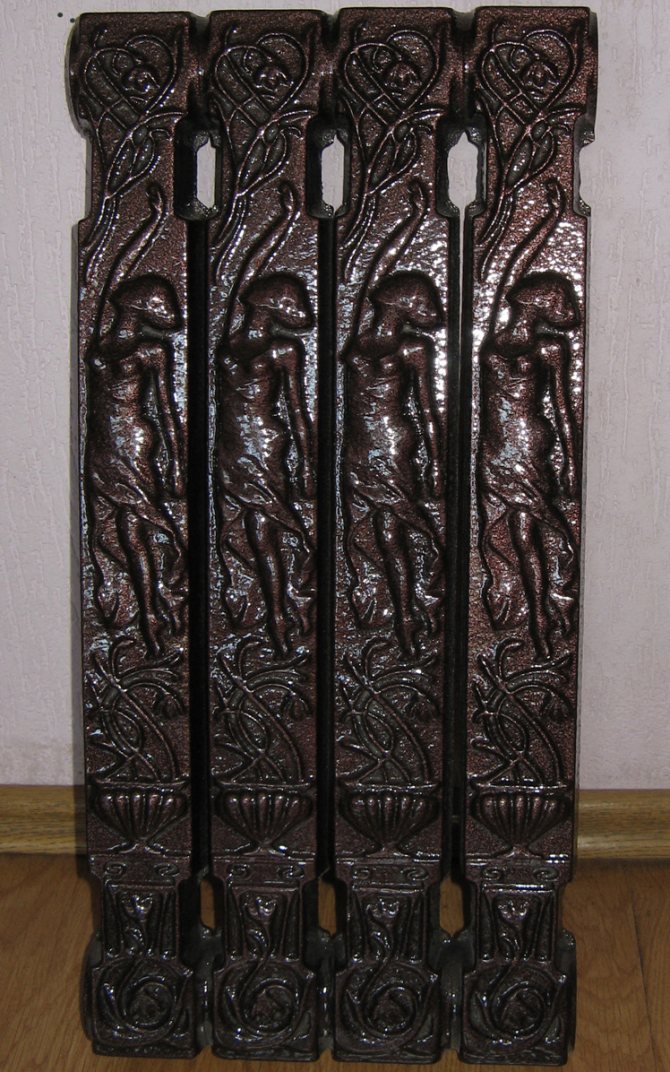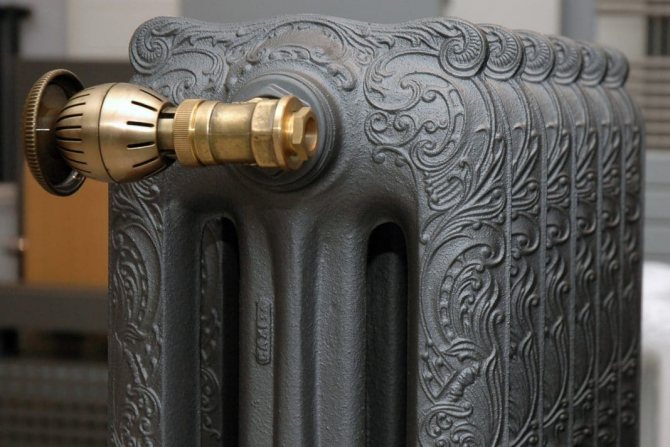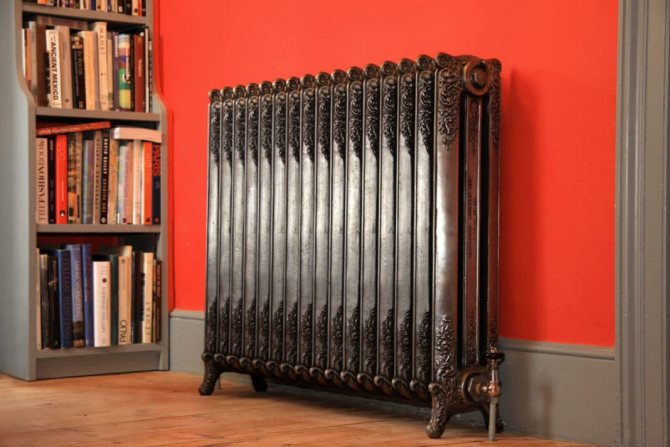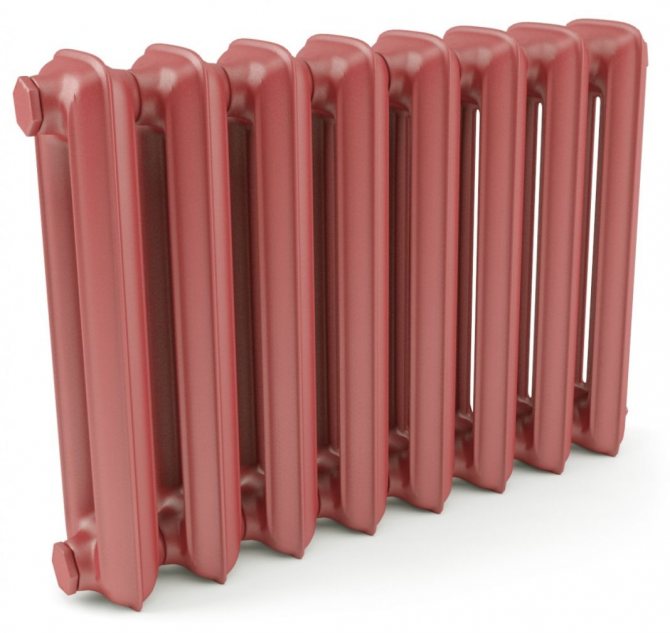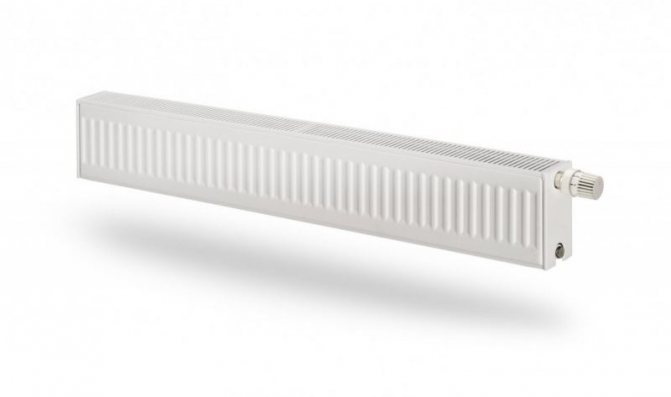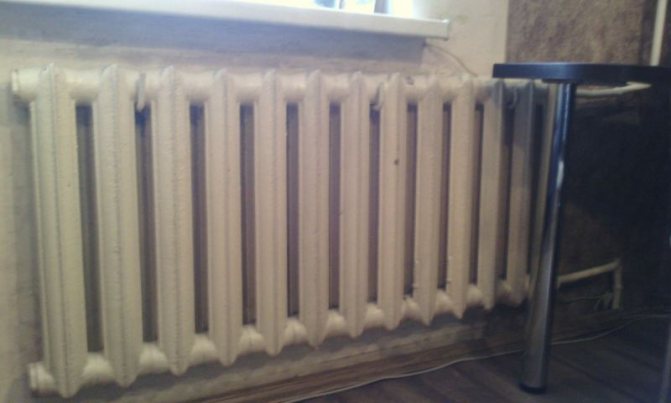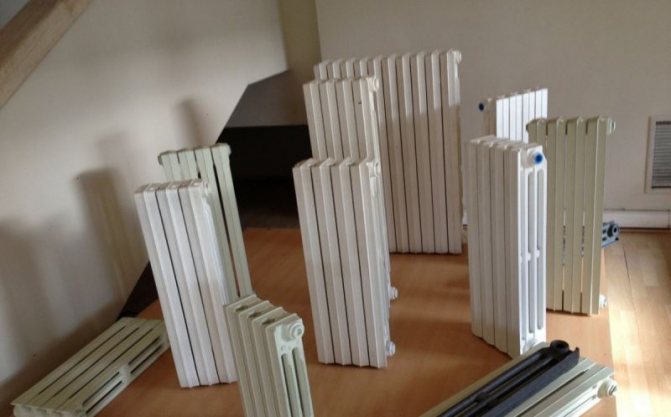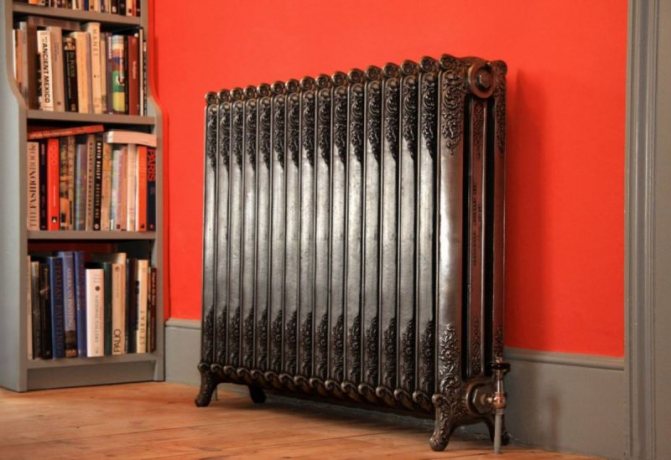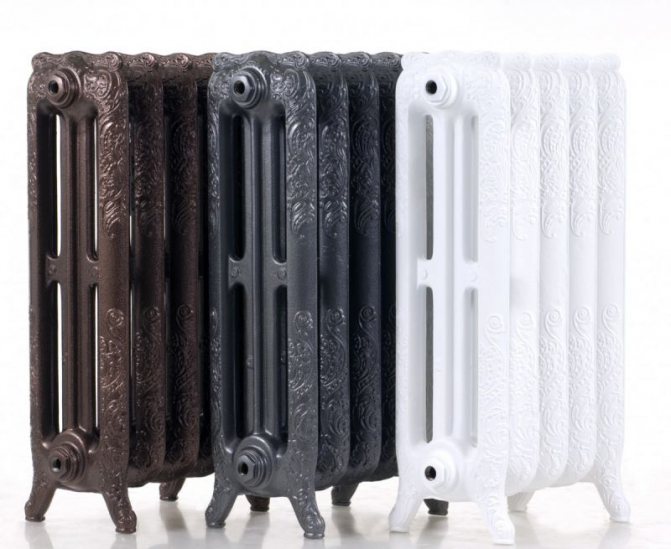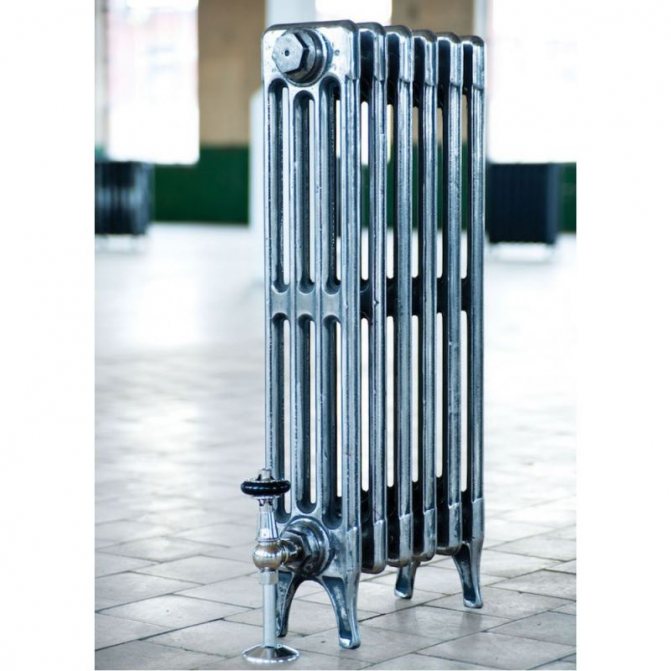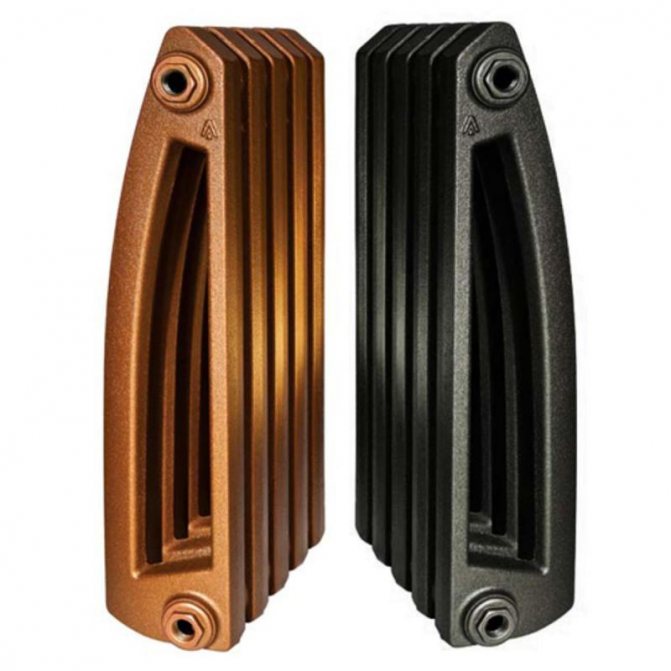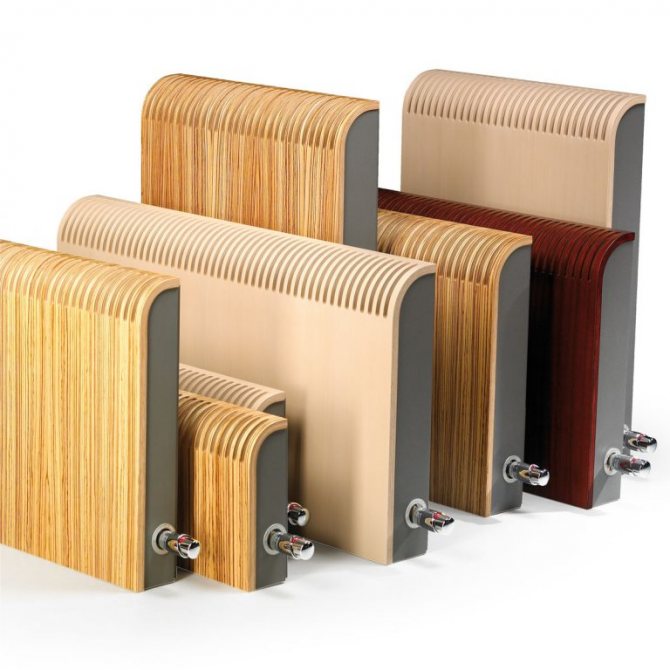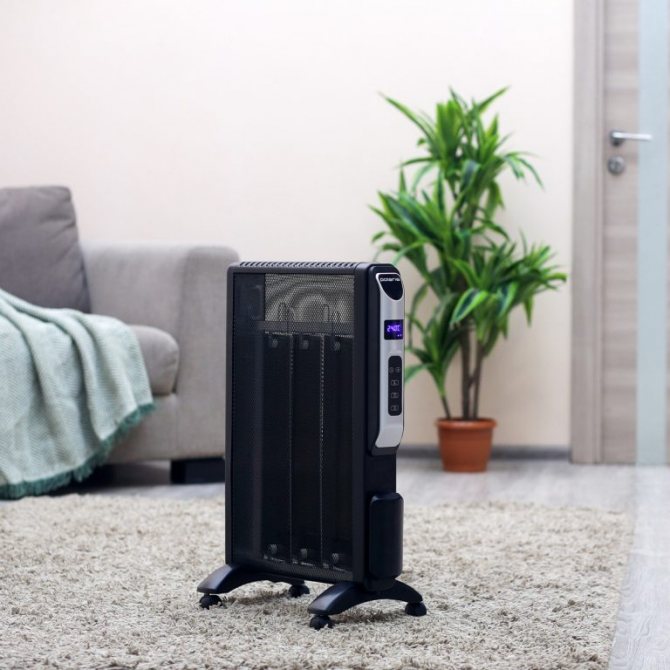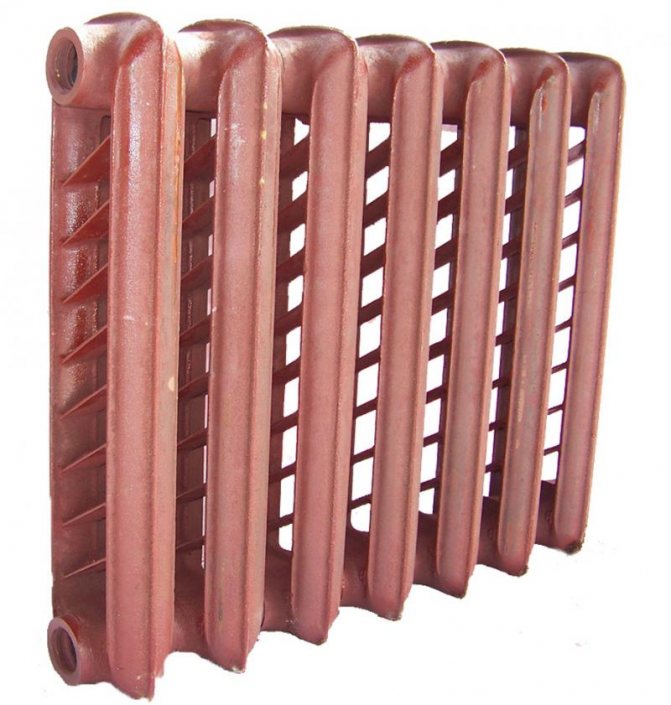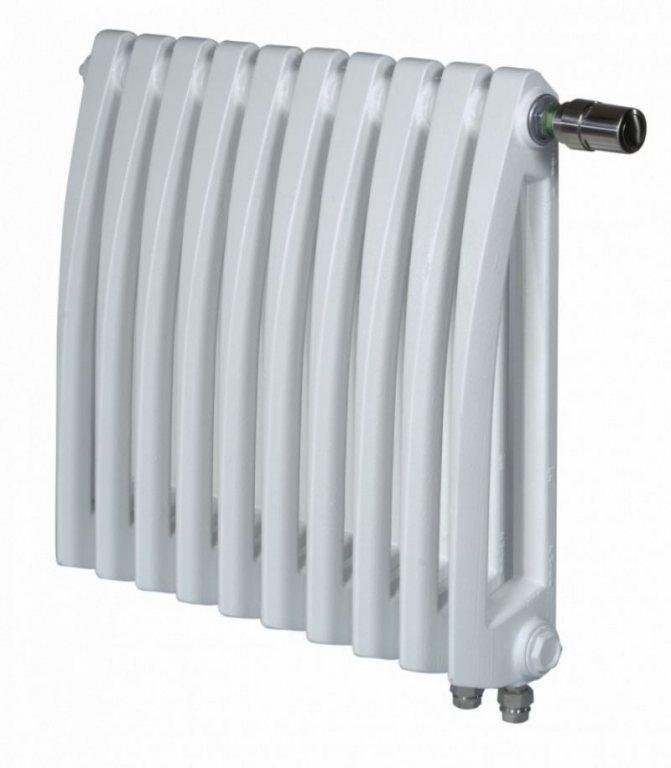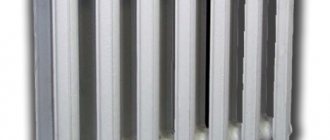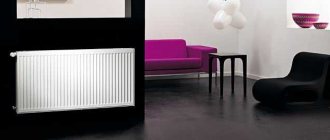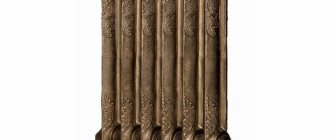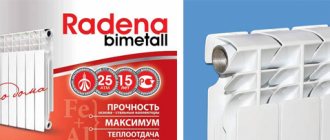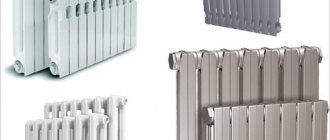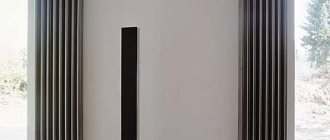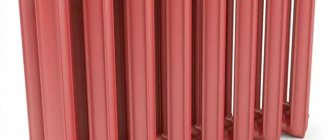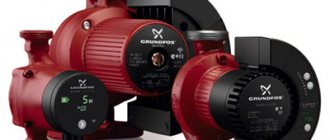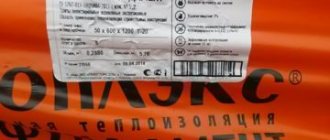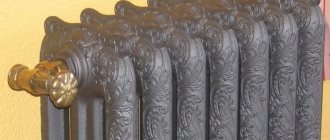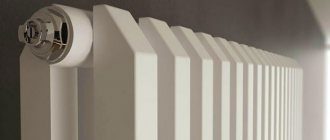Advantages and disadvantages of cast iron heating radiators
Classic cast iron batteries began to be massively changed in apartments, not only because of their heavy weight. Bored over the decades, their nondescript appearance is pretty boring. Sections from multiple paints are overgrown with thick layers and smudges of paint. For the interior of modern housing, such an attribute is inappropriate.
Older models were not beautifully designed
However, in terms of operational characteristics, cast iron products largely outperform metal counterparts. Manufacturers took this nuance into account and launched the production of heating radiators in an updated design. Modern products look stylish, do not spoil the interior of the apartment, even if it has been renovated.
Of the advantages, the following are distinguished:
- Cast iron is corrosion resistant. When contact with a liquid occurs, a protective layer is formed on its surface in the form of a thin film of rust. This deposit does not allow corrosion to penetrate inside the cast iron, excluding its destruction.
- The heating medium in heating is not only water, but also other aggressive liquids, for example, antifreeze. Cast iron radiators are capable of working with any of them, which cannot be said about metal, aluminum or bimetallic batteries. Here, for each heating device, it is necessary to select a coolant with a specific composition that will not destroy it.
- Cast iron slowly accumulates heat, but retains it for a long time. After switching off the heating, cooling does not take place immediately.
- The summer season is used by utilities for renovations. Water is drained from district heating systems for several months. When the metal is exposed to oxygen, it begins to rust quickly. However, this disadvantage does not apply to cast iron. Radiators are able to stay without a coolant for a painless long period.
- The cast iron sections are connected to each other by threaded nipples. The design feature indicates the maintainability of the radiator. If a section fails, it is easy to replace it or just throw it away. If desired, the user can independently lengthen or shorten the radiator, achieving optimal parameters for heating the room.
- The service life of cast iron batteries reaches 40 years. Old multi-storey buildings have rarities that are more than 50 years old, and they continue to function stably in heating. Modern radiators made of other materials cannot boast of such qualities.
The cost of cast iron models is available to most consumers, and this is another plus in favor of radiators.
Modern models are produced in an updated design
To have a complete understanding of cast iron models, it is worth considering their disadvantages:
- A huge disadvantage is a lot of weight. One Soviet-standard cast iron section weighs more than 7 kg. The mass of the radiator filled with coolant in 7 sections reaches 60 kg. It needs to be securely mounted on the wall. Old-style models are bulky. Due to the large thickness, part of the battery protrudes beyond the boundaries of the window sill departure.
- Keeping warm for a long time is not always an advantage. For this reason, radiators cannot be used in heating with automatic thermoregulation.
- Due to the lower thermal conductivity, compared to aluminum and metal, cast iron batteries heat up the room more slowly. In addition, they have a smaller heat transfer surface area.
- Due to their heavy weight, the radiators cannot be attached to lightweight walls with standard brackets. It will be necessary to build a stand for each heating device.
- The cast iron surface is slightly rough. Dust accumulates on it faster, which is more difficult to remove than from a smooth surface of a metal or aluminum radiator.
Knowing all the pros and cons, it is already easier to decide on the choice of batteries when arranging heating.
Advice! To prevent old Soviet radiators from spoiling the interior of the room, they can be hidden behind a decorative screen.
Conner Cast Iron Battery Specifications
Conner heaters also occupy the leading place among the sales of heating devices on the market. They have good technical parameters. Therefore, there are only positive reviews on cast iron Konner heating radiators. Batteries from this manufacturer are affordable. They are produced in different configurations, with different diameters of inlet pipes and a different number of sections.
The main technical characteristics of Conner cast iron radiators are given below:
- power - 120-180 W;
- the maximum temperature of the heat carrier is +110 degrees;
- battery operating pressure - 12 atmospheres. But the device can cope with a pressure of 20 atmospheres. Conner units are not afraid of water hammering;
- radiators have wide channels. Therefore, they do not create much local resistance.
The dimensions, weight and displacement of the section for this model are slightly reduced. On cast-iron Conner heating radiators, the owners' reviews can be summarized as follows: they effectively and quickly warm up the room, are durable, have an excellent design.
The choice of cast iron heating radiators is quite large today.
Choosing the right model for a specific heating system can be quite simple, you just need to rely on the properties and technical parameters of the device. Therefore, it is so important to know the characteristics of cast-iron heating radiators and be able to calculate the optimal values.
The choice of the type, model, size, power and other characteristics of the cast iron battery depends on the area and characteristics of the room, the number of windows and outer walls, and the conditions for using the heater. Any cast-iron heating battery, the characteristics of which correspond to the heated room, will work efficiently, create warmth and comfort in the apartment.
You can install a cast iron battery by calling a plumber or carry out this procedure yourself.
Otherwise, some problems may arise during the operation of the device. For example, the battery will not warm up evenly. Leaks may also occur. Most often, if the heating radiator does not fully warm up, the reason may lie precisely in improper installation. Therefore, if you are not a specialist, not confident in your knowledge and abilities, it is better to seek help from professionals.
You also need to ensure that the device is in good condition. Especially when the manufacturer's stated battery life is about to end. A cast iron radiator can last much longer than the specified period if the device is of high quality, installed correctly and maintained in good working order.
The heating equipment market is developing quite dynamically, which allows us to offer customers the most modern products. This statement fully applies to heating radiators, which are made of cast iron, copper, aluminum, steel or bimetal. This number of suitable materials for the manufacture of batteries makes it possible to create products with a very wide range of characteristics.
The most traditional batteries are cast iron, which have a number of characteristic advantages and are distinguished by the lowest cost. Modern cast-iron batteries have come to replace obsolete standard products, which will be discussed in this article.
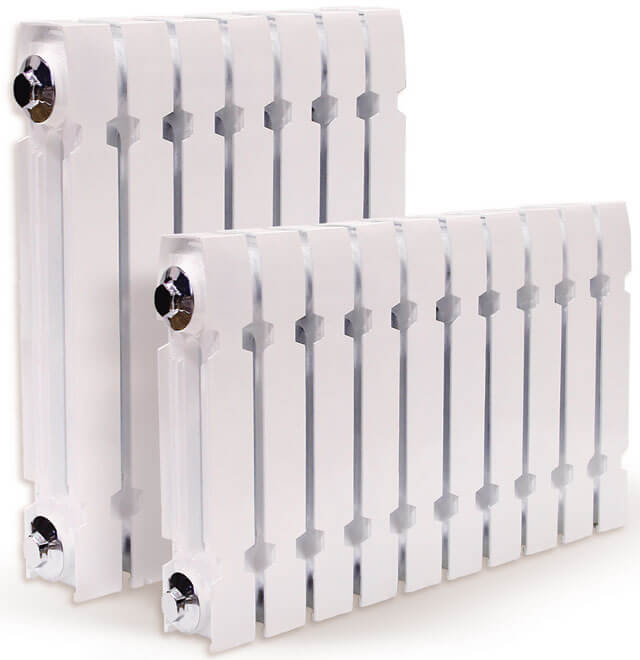
Which radiators are better: cast iron or steel
Modern batteries for heating are produced from non-ferrous metal alloys, which increases their heat transfer, service life and improves other parameters. However, such products are expensive. More often, when arranging heating, a person is faced with the choice of one of two types of available radiators - made of cast iron and steel.
Cast iron and steel radiators are the most affordable for home heating
To select the optimal model, you need to compare batteries from these materials. Steel and cast iron differ in their properties, which affects the performance of the finished product.
First of all, the following parameters are considered:
- dimensions and weight;
- design, the ability to choose different forms of execution;
- ease of installation;
- duration of operation in a specific heating system;
- heating rate, recoil and duration of heat retention;
- mechanical strength.
According to the first parameter, cast iron products lose. The radiators are heavier and larger. In theory, the steel product should be heavier, since the material has a higher density. However, this further increases its strength. To achieve equivalent performance, cast iron sections are cast in greater thickness. Naturally, they increase in size and weight.
If you do not take into account the old Soviet models, then the design of modern cast iron radiators is not inferior to metal counterparts. However, the choice of forms is still smaller. The problem is associated with the complexity of the production of cast iron products for heating.
There are also disadvantages for the ease of installation. Due to the high weight, reinforced fasteners are required for cast iron heating devices. If the apartment has a false plasterboard wall, then the installation of heating will bring more problems. Under cast iron radiators, you will have to build stands that do not look aesthetically pleasing.
Advice! If the walls do not allow for fastening with brackets, it is optimal to choose cast-iron radiators with imported legs for heating. They are installed on the floor like a conventional heater.
A cast-iron battery is more difficult to mount on a wall, in addition, an ugly bracket is often visible
With regard to the duration of operation, then it is necessary to consider the specific conditions and parameters of heating. Cast iron is resistant to aggressive effects of any coolant composition, does not collapse from contact with oxygen. Steel loses in this regard, but wins in strength. Cast iron sections are destroyed by mechanical stress, for example, accidental impact or when the radiator falls. Cracks can appear when a water hammer occurs in the heating. Under normal operating conditions, steel radiators will last up to 25 years, and cast iron ones - up to 40 years.
The heating rate, release rate and duration of heat retention by the radiator determines the heating efficiency. Here you need to consider a specific case. In modern apartments, heating is installed with temperature control for each room. It is important here that the radiators quickly heat up, give off heat and cool down. In this regard, metal models win for automated heating. Cast iron heats up more slowly than steel, which requires more energy consumption, but keeps heat longer. It is better to put such batteries on a country heating, where it is rarely turned on. After a single "run" of the system, cast iron will retain heat for a long time.
Making specific conclusions on the parameters considered, it is optimal to choose steel radiators for modern heating. They warm up the room faster, due to which there is less energy consumption. The advantage is low weight, ease of installation, attractive design, resistance to water hammer and mechanical stress.
The video shows a comparison of heating a cast iron and steel radiator:
Cast Iron Battery Technical Parameters
Specifications for cast iron radiators are given below:
- Heat transfer and power are the most important parameters of cast iron heating devices. Manufacturers indicate the capacity in the technical documentation, and for one section. The battery section averages 160 watts. In terms of heat transfer, cast iron radiators are two times inferior to aluminum and bimetallic counterparts. But this disadvantage is leveled by low inertia. Cast iron is able to keep heat for much longer and emit useful energy. Cast iron heating devices are most effective in systems with natural circulation of the coolant;
- Section weight. Each section weighs 3-7 kg. The number of sections can be different. It all depends on the specific model and parameters of the heated room. After installing the battery, sections can be added or subtracted as needed;
- Battery dimensions. The width of the section is 8-10 cm, the height is 37-57 cm, and the depth is 7-12 cm;
- The volume of the internal cavity can be from 0.7 to 1.5 liters;
- Operating pressure. It is the load that the coolant exerts during constant circulation through the heating system. As a rule, this indicator is in the range from 6 to 10 atmospheres. Usually, the operating pressure of 9 atmospheres is taken as the standard load;
- Pressure (or maximum) pressure. This parameter characterizes what maximum load a cast iron radiator can withstand during an unforeseen water hammer. When the heating system is checked, such a load is created inside the lines that is as close as possible to the pressure test. As a rule, in modern models, the crimping pressure is in the range from 12 to 18 atmospheres;
- The service life of cast iron batteries is quite long - from 25 to 35 years. But it can reach 50-60 years. And this is much higher than that of modern bimetal or aluminum radiators. The long service life is due to the fact that the dimensions of the internal channels are quite impressive. And this prevents blockages from appearing inside them. In addition, cast iron batteries do not enter into chemical reactions and are resistant to abrasion. And after several years of use, the batteries can be painted. We wrote about paints for heating radiators here.
Cast iron radiators are produced by different manufacturers, differ in a variety of models. Among the most widely used, one can name such heating devices as ms 140, sti nova and conner. Therefore, let us dwell on the consideration of the parameters of these batteries in more detail.
The best manufacturers of cast iron radiators
Batteries of domestic and foreign manufacturers are available on the heating equipment market. In terms of availability, it is optimal to consider the first option.
Classic domestic radiators MS-140 are still produced by the Nizhny Tagil plant
Among domestic manufacturers, the following firms can be distinguished:
- The Cheboksary plant produces its products under the name CHE.RAD. Batteries are produced with two and three channels with a depth of 102-120 mm. The popularity is due to the modern design, the lack of inaccessible areas where dust collects. In appearance, the products are similar to modern aluminum radiators.
- The Lyubokhonskiy plant produces batteries with a refined wall 85 mm deep. They are able to work in heating, where the coolant pressure does not exceed 12 atmospheres. In appearance, the products compete adequately with imported counterparts.
- The Nizhniy Tagil plant will satisfy the needs of classic lovers. The manufacturer produces products of the MS-140 brand according to the Soviet standard, but there are also new models of the improved design of the T-90.
Real German quality is reflected in the Guratec Apollo radiators
Products for heating systems of foreign manufacturers are overpriced by up to 4 times, but the demand for it is increasing.Among the popular brands are:
- The products of the Turkish company Demir Dokum have an exquisite retro design. Heating with Turkish radiators looks elegant even in luxurious mansions.
- The German manufacturer Guratec produces expensive products, but the quality and design are excellent. The cast-iron surface of the batteries is covered with a layer of special paint, on which it is difficult to put even a scratch.
Heating from imported batteries will be expensive. The cost of one product can vary from 36 to 130 thousand rubles.
What are European cast iron radiators?
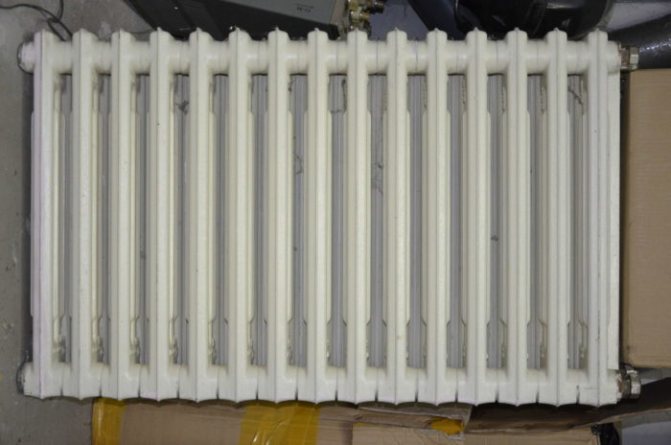

These are batteries that have improved performance and aesthetic appearance. Thanks to the use of additional components, the cast-iron batteries of the new model are distinguished by increased resistance to water hammer, they can serve up to 50 years and at the same time withstand pressure up to 18 atmospheres.
Visually, euro-cast iron products differ from standard ones only in aesthetics, the models are produced in a flattened shape that does not resemble an "accordion", can be rounded or remain multi-section, but at the same time with a flat panel and ribs hidden inside. Also, batteries have a special coating that protects products from mechanical shock and corrosion.
On a note! External changes did not affect the internal design of the batteries, the technical and practical capabilities of the radiators. Collectible decorated euro-iron radiators are expensive only because of their aesthetic appeal.
As with standard devices, euro-cast iron batteries have several connection options:
- Diagonal. The pipe for supplying the coolant is connected to the upper branch pipe, and the return flow pipe is connected to the lower branch pipe. The method is convenient for large radiators.
- Parallel. The upper branch pipe is equipped with a supply pipe, the lower one - with a coolant outflow.
- Lower. The supply and return pipelines are connected to the lower branch pipes. Such a wiring is more convenient when the battery is embedded in the wall, the communications are hidden in the floor.
If you choose euro-cast iron, heating radiators should be looked at by the type of connection and power. Compact devices are convenient for placement, have less weight and look attractive without requiring additional screens to hide the unassuming accordion of sections.
How to choose cast iron heating radiators for an apartment
Design is not the main selection criterion. There will be no difficulty here. The owner for his heating without outside help will select a radiator that is suitable for beauty and price. The only important parameter that needs attention is power. The calculation is performed according to the following rules:
- for a room with a standard ceiling height, where one wall and a window face the street, a power of 120 W / m2 is required;
- if the window is equipped with an energy-saving glass unit, the indicator is reduced by 15%;
- for a heating system operating with a coolant with a temperature of up to 70 ° C, for every 10 ° C of the difference, add from 10 to 15% of the power;
- for a corner room with two walls facing the street, 10% is added to the calculated total power.
Knowing the parameter of a particular radiator model and the calculated power of the room, they choose suitable heating devices for their heating.
Dimensions and power
Heating radiators were put into operation very given, so the standards have been preserved since the times of the USSR. The main indicators are that the distance between the center of the axes of the supply and discharge pipelines is 300-500 mm, but the depth and width of the sections are not regulated, so manufacturers produced different types of radiators. Today's models are also being adjusted to the established standards.
It is best to look at the parameters of the size, power and heat transfer of cast iron heating radiators in the table:
| brand, model | Section parameters H / W / D | Working pressure (atm.) | Thermal power kW | Heating area 1 section m2 | Coolant volume in 1 section (l) | Weight of one section (kg) |
| MS-140 | 388-588/93/140 | 9 | 0,12-0,16 | 0,244 | 1,11-1,45 | 5,7-7,1 |
| World Cup1 | 370-570/80/70 | 9 | 0,075-0,11 | 0,103-0,165 | 0,66-0,9 | 3,3-4,8 |
| World Cup2 | 375-572/80/100 | 9 | 0,1009-0,1423 | 0,148-0,207 | 0,7-0,95 | 4,5-6,3 |
| World Cup3 | 370-570/90/120 | 9 | 0,1083-0,1568 | 0,155-0,246 | 0,95-1,38 | 4,8-7,0 |
| Konner Modern (euro iron) | 565/60/80 | 12 | 0,12-0,15 | Multi-section design | 0,66-0,96 | 3,5-4,75 |
Rating of the best cast iron heating radiators for an apartment
Ratings often help to make the right choice of the best model. They are compiled taking into account consumer feedback. Below is a rating on the quality of cast iron heating radiators, which includes models of different price categories.
VIADRUS STYL 500/130
The model has a modern design. Withstands heating of the coolant in the heating system up to 115 ° C. The maximum operating pressure is 12 bar, and the allowable pressure test is 18 bar. The section holds 800 ml of coolant.
A Czech-made model costs about 27 thousand rubles
KONNER MODERN 500
The radiator is capable of operating in a heating system with standard parameters. The cast iron walls withstand a pressure of 12 bar. One section holds 900 ml of coolant. Due to the thin walls, rapid heating and heat transfer occurs. The device with 12 sections can heat a room up to 27 m2.
The German model was produced at a Chinese plant, it costs about 4 thousand rubles
STI NOVA 500
The radiator is capable of operating in a heating system, where the coolant temperature reaches 150 ° C, and the short-term pressure is 18 bar. The thermal power reaches 1200 W, which allows you to heat a room up to 20 m2.
The popular model costs 7.5 thousand rubles, it is considered a hit of sales
GuRaTec Apollo 765/05
Stylish solution for lovers of rare books. The radiators are equipped with feet, which allows them to be installed on the floor without the need for hanging. The option is convenient for rooms with weak walls. The product consists of 5 sections, each of which holds 210 ml of coolant. The maximum power is 725 watts.
Models are copies of French products
МЗО МС-140М-05
The standard model consists of 7 sections, but you can dial any number of them if you wish. The design is still of the Soviet model. Due to the budget cost, the radiator can be installed in a non-residential area or covered with a decorative screen.
A conventional Soviet-standard battery is still in demand
The device and principle of operation of aluminum radiators
Due to the peculiarities of the design and the material from which they are made, aluminum radiators show the highest heat transfer coefficient. Models are often distinguished by their laconic appearance and reasonable cost.
Aluminum radiators have clear geometric shapes, modern design. However, after a wave of accidents associated with these heating devices, they lost a lot of demand. Today, the consumer, when choosing a device for heating, studies the features more closely.
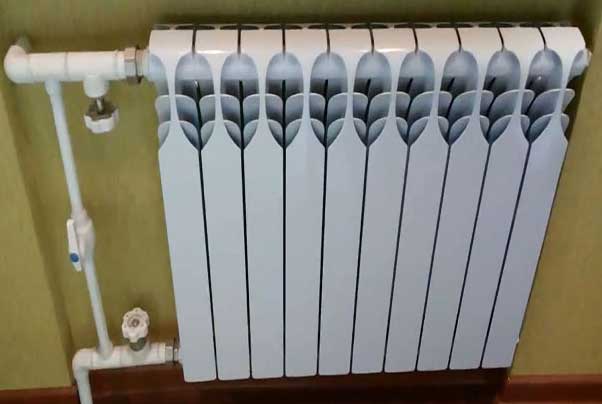

Aluminum models come in a variety of sizes and capacities. The radiator consists of several separate sections or collectors. Various alloys of aluminum and other metals are used for their production.
The most common height of devices is 35, 50 cm. In length, such systems can be recruited depending on the required number of sections. Factory radiators are supplied in sections of 10. And this can be called an advantage, since factory stranding is much more durable.
The role of the coolant in such a radiator is played by water, which can have a negative effect on the device. In order to protect it from oxidation, many manufacturers treat the inner surface with a polymer composition. Radiators that have not undergone this treatment are unsuitable for use in multi-storey buildings.
Today, two types of aluminum radiators can be distinguished:
- a conventional model designed for 6 atm .;
- reinforced model designed for 16 atm.
It is worth noting that inexpensive, low-budget models are more suitable for use in private houses, houses with an individual heating system.
Tips & Tricks
Comfort in the house depends on the efficiency of heating, as well as lower costs for paying for energy resources. A couple of useful tips will help solve sensitive issues:
- If there are already cast-iron batteries in the house, and they have begun to heat worse, you should not change them for this. The heating system may be clogged. Sludge has settled inside the sections, which prevents the normal circulation of the coolant. Heating appliances can simply be washed and will work great.
- When installing new heating for a private house or summer cottage, cast iron heating devices will be a good choice. They keep warm for a long time, even if the fuel in the boiler goes out.
Before buying radiators, you need to make sure that this is the only correct solution.
Finally, it is worth noting that it is undesirable to frequently engage in staining. With each layer of paint, heat transfer decreases, since it is a kind of insulator.
Advantages of cast iron batteries
European cast iron heating radiators are valued for an extensive list of advantages, including:
- Long service life. Euro batteries with proper care can last over 50 years. If the operating conditions of the radiators are favorable enough, then during all this time the devices will not need to be repaired. This advantage is especially important considering the incredibly low cost of cast iron radiators.
- High heat dissipation. The effectiveness of cast iron batteries is largely due to the fact that their ribs are located vertically. In addition to the successful design, the characteristics of the cast iron itself play an important role - this material is distinguished by high inertia, which allows it to accumulate thermal energy and give it away even if the heating system suddenly stops working.
- Resistant to high temperatures. Since cast iron can withstand high temperatures (up to 150 degrees) well, batteries made of this material are excellent for arranging heating systems.
- High mechanical strength. Modern cast-iron radiators are quite durable - the working pressure that they withstand reaches 18 atmospheres. In addition, the inherent strength of cast iron also makes it possible to survive crimping without problems.
- Corrosion resistant. For ordinary cast iron, this characteristic is irrelevant - the composition of cast iron includes iron, which is corrosive. Manufacturers of heating devices are aware of this fact, so they cover cast-iron batteries with a special composition that does not allow products to come into contact with air, which provokes the oxidation process.
- Low hydraulic resistance. The value of the hydraulic resistance in cast iron radiators is relatively small, which is due to the large diameter of the pipes supplying the coolant to the device, and the large dimensions of the sections. Low hydraulic resistance makes it possible to successfully use euro cast iron radiators in systems with natural circulation of the heat carrier.
- Versatility. The versatility of cast iron heating devices is manifested in the fact that they can work with any coolant, regardless of its composition.
- Low cost. Modern cast iron batteries are quite cheap, especially considering all their advantages.
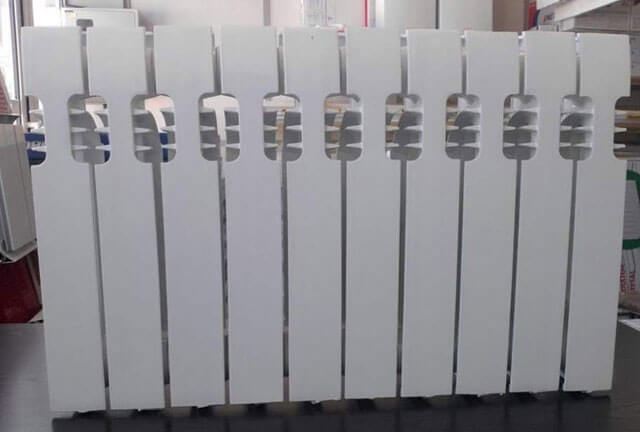

All of the above qualities, coupled with good visual data and relative ease of installation, make beautiful cast-iron batteries an excellent choice for arranging a heating system.
Difference between cast iron and bimetallic batteries
Radiators, consisting of two types of metals at once, came to the domestic market from Italy and quickly won the hearts of consumers, despite their high cost. This can be explained in one word: "reliability". If you choose which is better, cast iron or bimetallic batteries, then you should refer to a comparison of their technical indicators:
- Structure:
- Cast iron structures now look stylish, but they are also assembled from sections equipped with a fairly wide channel for the coolant. Their weight has become much less (3.5 kg versus 8 kg earlier), the look is presentable, and the reliability is the same. On the market there are classic sectional models and artistic, in retro style. The latter are very expensive and mostly imported.
- Bimetallic structures consist of a steel or copper core with aluminum fins and a casing. The coolant comes into contact exclusively with stainless steel, which protects the device from corrosion, and the casing provides high heat transfer. Such a heater weighs a little, it is easy to install, and additional thermostats allow you to monitor the heating of the coolant.
- Heat transfer level:
- If you decide whether cast-iron or bimetallic radiators heat better, then their indicators will be approximately equal... So the heat transfer from the cast iron section ranges from 100 W to 160 W. Many consumers think they take too long to warm up and they are right. At the same time, everyone forgets that these batteries also cool for a very long time.
- The heat transfer of one section of a bimetallic radiator is 150-200 W, which, with instant heating, brings this type of heaters to a leading position.
- Operating pressure:
- Although many years of experience in operating cast iron batteries suggests that they are strong and reliable, this is not entirely true when it comes to high-rise buildings. Even in five-story buildings, water shocks can occur in the heating system, which are quite strong, let alone buildings of 16 floors and above. The working pressure of cast iron batteries is 9-12 atmospheres, which may not be enough with a sharp rise in pressure, for example, up to 15 atmospheres. In this case, the cast iron sections will simply burst.
- Bimetallic radiators are more reliable, since their operating pressure is 25-40 atmospheres, and in some models even 100 atmospheres. At this point, structures of two types of metal are also in the lead.
- Resistance to coolant:
- Cast iron is absolutely "indifferent" to the quality of water and its acidity. Its complete discharge for the summer period does not affect it, but the pebbles that sweep through the system gradually weaken the cast iron, exude it and disable it. This process is long, and if the walls of the radiator are of sufficient thickness, then it is completely endless.
- The bimetal radiator is weaker in this respect. He is not afraid of the acidity level of the water while it is in the system, but as soon as it is drained, corrosion begins to appear after 2-3 weeks of contact with air. In this indicator, bimetal loses to cast iron.
- In terms of temperature, both types of radiators tolerate its changes well. For cast iron, the maximum water heating is +110, and for bimetal - +130 degrees.
- Today you can find cast-iron batteries, the age of which has passed the 100-year mark, but on average they have a service life of 50 years. Manufacturers set the limit for bimetallic radiators 25-30 years, which is less than that of cast iron.
Bimetallic heaters are the best option for replacing old batteries. In general terms, they are superior to cast iron devices, which guarantees their efficient operation in an unfriendly district heating environment. In addition, they are much easier to install, lightweight and do not require additional maintenance.
If the question is whether to change cast-iron radiators to bimetallic ones or not, then tenants of five-story buildings do not have to do this, especially since the latter devices are twice as expensive... Residents of high-rise buildings will have to abandon cast-iron batteries, since they will not withstand the load of the system and will leak. In this version, there is definitely nothing better than bimetallic structures.

